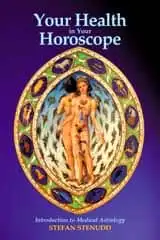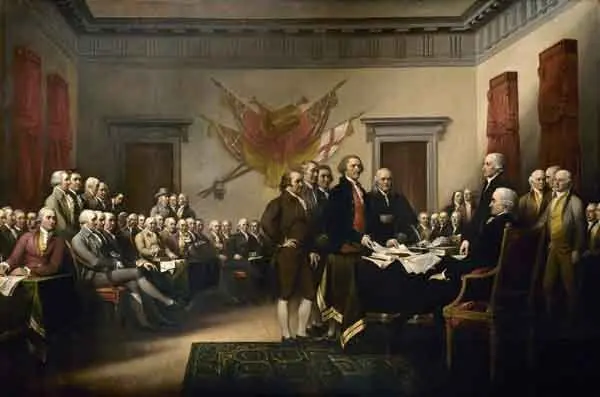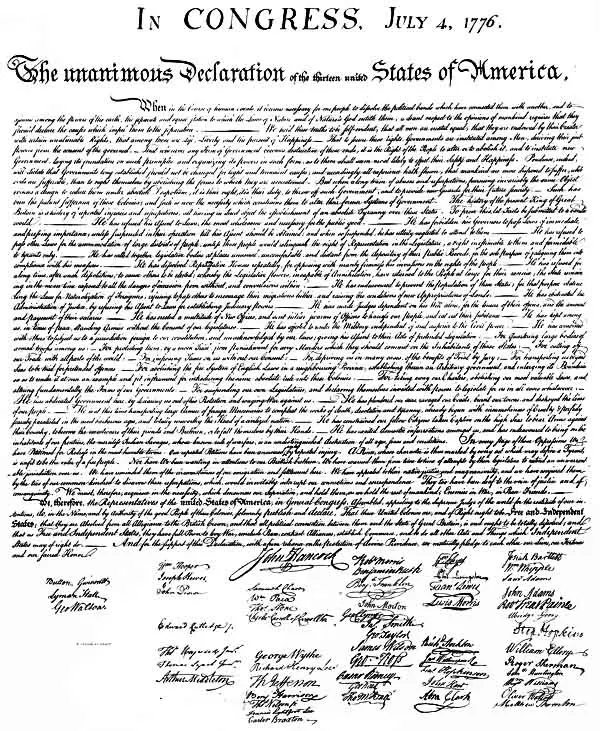|
by Stefan Stenudd
|
Time of Birth of the USAThe USA Complete Horoscope 2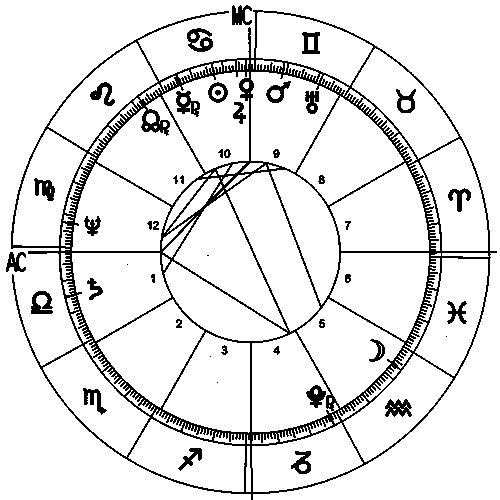
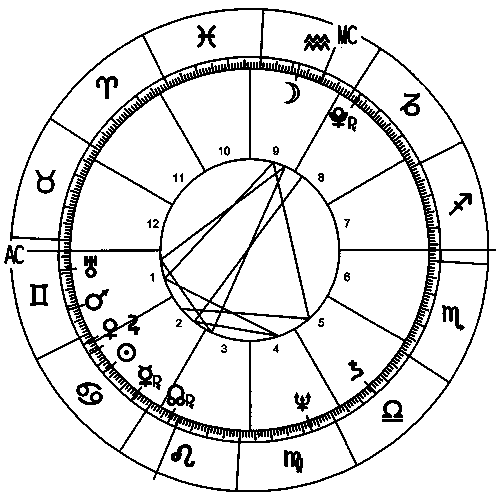 USA horoscope for 02:00 AM, July 4, 1776 in Philadelphia.
The Sibly chartCampion points to the horoscope published already in 1787 in A new and complete illustration of the celestial science of astrology (London 1784-97), by the British astrologer Ebenezer Sibly (1751-1800), who calculated his American horoscope on a time of around 5 PM.
Sibly wrote on the occult sciences, himself naming the Swedish mystic Emanuel Swedenborg as a prominent source for his ethereal perspectives, but in the case of the US birth date his source of information might have been Thomas Jefferson, who has pointed out the afternoon as the moment of decision on the declaration. Here is an excerpt from Thomas Jefferson's autobiography of 1821, regarding the event:
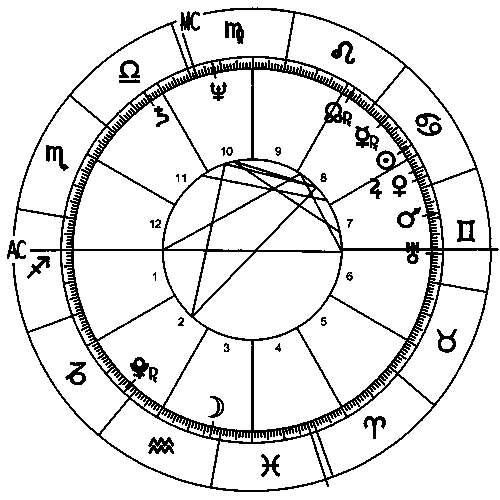 USA horoscope for 5 PM (17:00), July 4, 1776 in Philadelphia.
Ron W. Howland, who has researched and written on the subject, has been kind enough to inform me, in private correspondence, that Thomas Jefferson is the only one of the eye witnesses, who has stated that late time of day.
The Howland estimateRon W. Howland, who has studied the historical as well as astrological circumstances in detail, suggests convincingly an earlier outcome of the Congressional handling of the matter.Around 11 AM is his estimate, from which he extracts a US horoscope for the exact time of 10.55, carefully pinpointing the minutes by rectification, an astrological method of finding a birth date by seeking out planetary positions to explain certain important events in the life of the one whose chart is made. When charting the 10.55 time, he got a horoscope with a number of correlations to important events in American history.
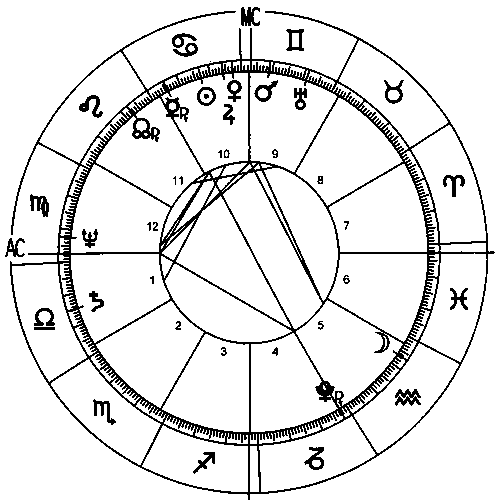 USA horoscope for 10:55 AM, July 4, 1776 in Philadelphia.
The Journal of the CongressNow, the sessions of the Congress have been recorded in its own Journals, which are easy enough to find, nowadays also on the Internet at the Library of Congress website, but sadly they do not specify a time of day for the actual decision on the declaration.Still, the proceedings of Thursday the 4th of July 1776 are clearly presented in the Journal from that day. The Congress resumed at nine o'clock, according to what was stated lastly on the Journal of the previous day: "Adjourned to 9 o'Clock to Morrow." The meeting started by deciding on some military matters, then:
The committee of the whole seems to be a diplomatic way of stating that the draft of the declaration was freely debated by all the congressmen, in a less orderly fashion — what we would call a free discussion.
"Some time"Unfortunately, there is no certainty as to how long "some time" might have been, but considering that the draft to the declaration had been discussed during previous days of the Congress, it is safe to assume that President John Hancock would have been eager to reach a conclusion.He was clearly a forceful leader of the meeting and a man of action, signing the document with big and strong letters, stating that he wanted to make certain that the British king would be able to read it.
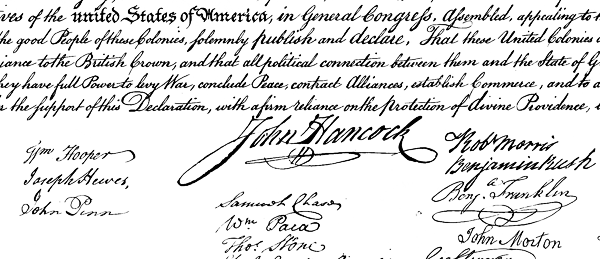 Detail, Declaration of Independence.
I dare to surmise that this was the case on the 4th of July as well. The President could cut the debate short, since it was generally understood, anyway, what the outcome of the vote would be.
How about lunch?The Journal of the day gives additional arguments for this.When the declaration had been approved, the Congress continued by making some decisions regarding the printing and distribution of the document. Next on the agenda was a completely different matter, followed by a series of others, none of them related to the question of the declaration of independence — nor, would I say, of that magnitude. After several of those, the Congress was adjourned until 9 o'clock next day. I cannot fathom that the Congress would have gone from the crucial and almost traumatic matter of the declaration of independence to the rest of the day's affairs, without even a moment to catch their breath. There had to be a pause. How about lunch? Even the strong willed leaders of the revolution had to eat, and this must have been foreseen by the President. He could have pressed for a decision before lunch, or allowed the "committee of the whole" to debate the matter right up until the break for lunch, initiating the afternoon session with deciding about it. Had the latter been the case, I would have expected another wording in the Journal, than the one quoted above, which seems so clearly to indicate that the President puts a stop to the debate. He would know, also, about the risk of letting a discussion go on without a definite stop — who knows what might come up during lunch, if the question had not been solved beforehand? No, any Chairman with some experience would do his uttermost to have the business over and done with before lunch.
The draft of the Declaration of Independence is presented to the congress. Oil painting by John Trumbull, 1819.
The agenda of the dayThen the number of matters following that of the declaration, as well as their nature, makes perfect sense. The big issue is solved and put aside, so the Congress is free to move on with completely different matters.It is almost like a new day has started, which would explain why Thomas Jefferson had the impression that the decision on the declaration was made late that day — to him, being the writer of the document, the day was pretty much over when it was passed. In short, the agenda of the 4th of July would have looked like this:
Nothing in the Journal indicates that they felt fatally pressed for time. The President would therefore have liked to end the morning session by noon, at the latest. Hunger can be a good argument for accepting a proposal, but it is dangerous to play on — with too much hunger there is no way of reasoning.
25 lb. of powderThe number of matters after the declaration also indicates that a lunch break preceding them could not have been too late in the afternoon, if they were to be ready at a reasonable time.The last matter of the day, the selling of some 25 lb. of powder, seems not to be of such hurry that it could not have been postponed to the next day, if the session was running late in the day. Therefore it is safe to assume that they closed the meeting at a normal time of day.
The morning scheduleLooking back at the morning of the 4th of July, the matters dealing with the war seem to have been urgent enough, as such matters always are, but not lengthy. Applying for flint to the New York troops, additional troops to be moved to Philadelphia, and that was it. Nothing controversial, it seems. If the session started not much later than 9 AM, I imagine this would have been done by 9.30.Then, the president opened for free discussions of the declaration. What time span would he have in mind for it? If he had hopes that it would be solved during the day, and this seems to be the case, he would have known to keep it short, not to have it swell into yet unpenetrated areas of reasoning, looking for a closure before lunch. Anything shorter than an hour would still have been overly optimistic, but far above that he would have been unwilling to go. Probably, he would have forcefully put a stop to it at about 11 AM, if needed, to try an approval before lunch, and if the debate seemed to die out beforehand, he would certainly be in a hurry to move on. That would make anything from 10.30 to 11 likely, as the clock when the debate was stopped, and times before or after this interval increasingly unlikely.
Between 11 and 11.30By Mr. Harrison's statement that an agreement was reached, we understand that there could not have been too much editing needed this day, and that things moved smoothly once the President had resumed the chair. The reading of the declaration and the procedure of vote probably took no longer than about half an hour.This would put the time of decision to somewhere between 11 and 11.30, leaving half an hour or so for the quick decisions about printing and distribution, before the well deserved lunch.
On the other hand, in politics matters of utter importance move quickly or slowly, rarely in between.
Pondered for daysThe draft of the declaration had been pondered for days, rewritten and what not — although with rather minor alterations — until the day of the decision. If the draft would still have been provocative in essential parts, it would have been discussed all through the day, at least, and a decision on it would have been the last thing the Congress did, after which to adjourn and rush to their beds or to the nearest bar.The fact that they continued the day's session in quite a productive way, making a number of practical decisions on matters big and small, suggests strongly that they were not fatigued by the matter of the declaration. Thus, it may very well have been a decision very quickly reached. That would also explain why they bothered to make rather detailed decisions on the printing and distribution of the document — they were not exhausted at all. So, something a bit earlier than 11.30 seems the most likely, after all. Earlier than, say, 11.15, I would not be convinced to go, though. I mean, just the reading out loud of the document would exceed a quarter of an hour, so an earlier time of decision would mean hardly one hour of free debate — and what congregation of politicians would be possible to fit into such a short time of debate? In conclusion, then, I find the above argue for a US horoscope based on the time 11.15, keeping in mind that this is an approximation — the midpoint of the very likely interval 11 to 11.30. This is the chart I will interpret in the following.
A confessionBut here I must pause for a confession. Although it is my strong conviction that a horoscope should not be calculated on rectification, which can never be more than a subjective argument of little common value, I have — to some extent — allowed that to happen here.Having studied a number of alternative US horoscopes, made for different times of day on the 4th of July, I have found myself particularly attracted to that of 11.15 — more so than for example 11.00 and 11.30. That may very well have influenced my reasoning above. There's the Libra ascendant, its trine to Pluto in the fourth house, Venus in the tenth house and not the ninth, and so forth — things I will comment in my interpretation below. These things put together seem to me to portray the US of A more accurately than the other horoscope charts I have seen. But most of all it is a gut feeling, if you like, an intuitive preference, which preceded the observations of details such as above mentioned ascendant, Venus et al. You decide, of course, to what extent you will trust my arguments above, as well as my instinct. If I made any higher claims, as to the proof behind my choice of time for the horoscope, you should not trust me at all.
Trying it out
The USA Complete Horoscope
MenuCOMPLETE HOROSCOPEHow to Make Your Own HoroscopeYour Health HoroscopeSex in Your HoroscopeZodiac ArchetypesFinancial AstrologyDaily Horoscope Guide — What to ExpectTetrabiblos — the Ancient Astrology BibleHOROSCOPE BASICSZodiac — the "how" of the horoscopePlanets — the "what" of the horoscopeHouses — the "where" of the horoscopeAspects — the "why" of the horoscopeFAMOUS HOROSCOPES2024 presidential election horoscopes for Donald Trump and Joe BidenJoe Biden's 2020 presidential election horoscopePete Buttigieg's 2020 presidential election horoscopeDonald Trump — impeachment horoscopeDonald Trump — will he resign?Hillary ClintonMike PenceBarack ObamaAnders Behring BreivikMichael JacksonSarah PalinBrad PittThe USA Horoscope — Finding and Reading ItPREDICTIONSThe USA Pluto return 2022 horoscopeCapitol attack horoscopeCovid-19 coronavirus horoscopeFuture of the InternetThe Age of AquariusUSA 2016 ElectionMundane Pluto — Its Effect on SocietyMundane Neptune — Its Effect on the ArtsMISCAbout the Complete Horoscope WebsiteDisappearing Ascendant — Latitude EffectsThe Envelope Chart — Horoscope of the PastAstrology LinksAstrologi på svenskaContactCookiesZODIAC SIGNSThe twelve Zodiac signs and what they mean in astrology.
MY OTHER WEBSITES
Tarot Card Meanings
I Ching Online
Stefan Stenudd
About meI'm a Swedish astrologer, author and historian of ideas, researching ancient thought and mythology. My personal website: stenudd.com
|
